View current page
...more recent posts

Bill Schwarz's 99 Bottles of Beer on the Wall begat Cady Noland, and Cady Noland begat...
Brooklyn-based artist Roy Stanfield, who has the most persuasive website of almost any artist whose work I've never seen, and whose drawings based on random Google image searches I posted about here. He's having a show at And/Or Gallery in Dallas, with Wendy Red Star.
Some photos of the show are here; the statement at the bottom of the page is very helpful.
The gallery's page documenting the show is here.
I'm being a bit cheeky about the website and all, but seriously, that is an inspiring series of photos documenting the artist's work. Almost no text is needed--with such a range of amusing, perplexing, and drop dead pretty installation shots (see the photos of skateboard ramps/swimming pools) the viewer supplies the back story and imagines radical exhibition scenarios that may or may not have happened. With its seamless mix of "exhibition space" and "environment" it is a thesis for an excellent career. Maybe I'll get to see the work in a New York gallery eventually.
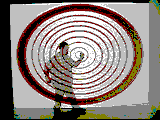
I know a lot of people watched CNN during the First Gulf War (the "good gulf war") and came to love the network's exciting style of round the clock reporting and showing that same clip of Saddam brandishing the shotgun over and over. I thought the network was just the lyin' propaganda arm of the government and I couldn't stand to watch it. Nothing's changed in 15 years. Here's a report from Salon's Tim Grieve:
Wait, you mean we didn't find any WMD?
From the "Earth to CNN" Department comes this Media Matters report on an otherworldly on-air exchange Thursday between CNN senior national correspondent John Roberts and CNN anchor Wolf Blitzer.
The subject was sanctions against Iran, and Roberts began by saying that the United States and its allies might not be able to get them through the U.N. Security Council. Fair enough. Then he said that sanctions don't always work. That's fair, too, and it might have been a good place to stop. Roberts kept going. "Don't forget," he said, "Iraq endured 11 years of sanctions, and, you know, we still had to go to war to get rid of what it was that they had."
Blitzer, who knows a thing or two about Iraq, immediately set Roberts straight, reminding him that the U.S. war against Iraq didn't, in fact "get rid of what it was that they had" because, as it turns out, they didn't have anything at all.
No, wait. That's not what Blitzer actually said.
What Blitzer actually said was, "Good point, John. Thank you very much."
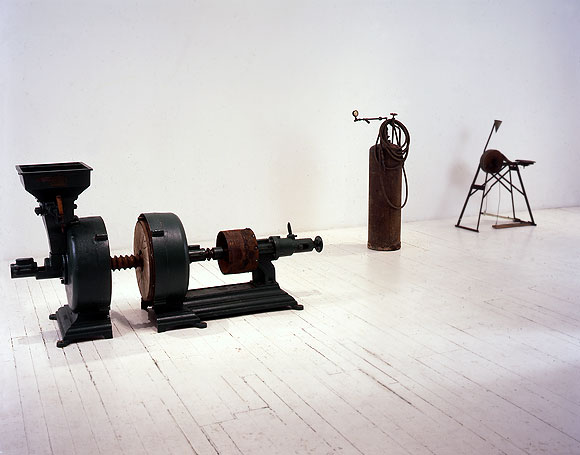
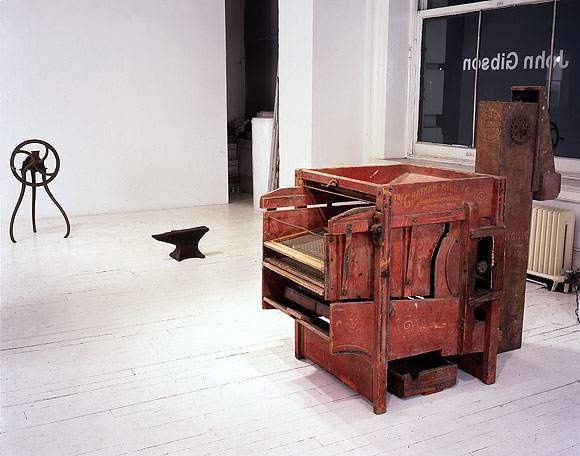
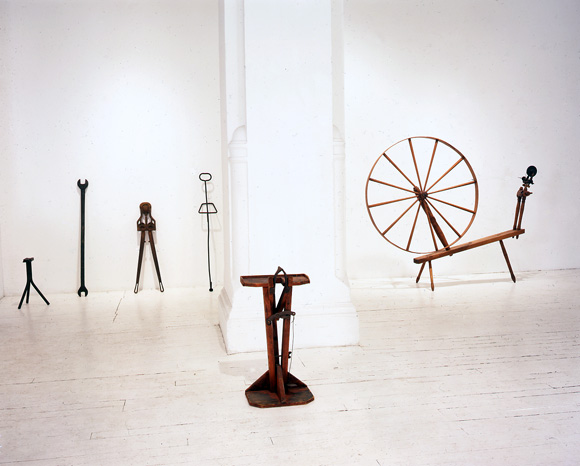
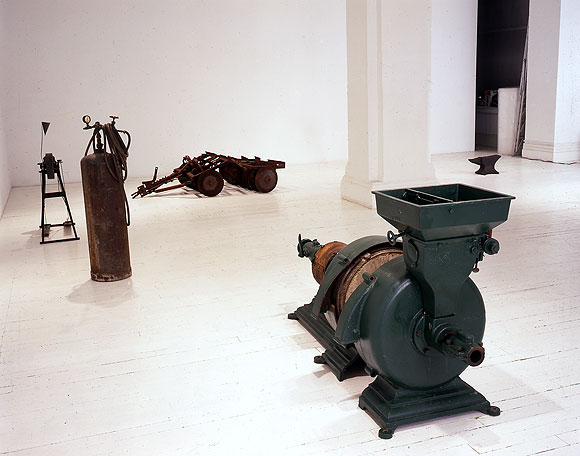
Bill Schwarz, installation views of solo show at John Gibson gallery, New York, 1995 (photos by Sylvie Ball). While the artist Cady Noland made urban detritus (machine parts, flags, key chains, beer cans) the focus of her found object/scatter installations, her contemporary Bill Schwarz, who was included in a number of Robert Nickas-curated shows around the time she was coming to prominence, took the more radical and I would say Robert Smithsonesque step of looking to the American heartland for appropriation subject matter. For this show at Gibson he trucked a selection of rusty, not-quite-obsolescent farm machinery into the white cube of the gallery and arranged it tastefully, a la MOMA curator Alfred Barr's "art of design" shows.
I say radical for a couple of reasons. In a way there's nothing more alien to a cosmopolitan New Yorker than these implements from red states, as we now call l them. Much of the equipment is obscure to the urbanite and seems completely divorced from function, yet is a matter of life and death to the (pre-agribusiness) farmer hacking a living out of the land. The exhibit follows the core principles of what Smithson called the "non-site"--a real place in the world transplanted into the white cube. The show is also "difficult" because of flirtation with kitsch far more threatening to refined urban sensibilities than Noland's Canal Street, dollar store ephemera: these battered, time-patinaed harrows and spinning wheels can be found all over the heartland tucked away in antique stores, used as flower pots, and so forth. The difference is the "Barr treatment" Schwarz gives them; the objects are arranged for maximum formal elegance, so that they resemble shows of mid-20th Century modernist sculpture, much as Barr arranged tools and machine parts, deliberately pointing up their affinities to Brancusi, the Cubists, et al.
The price of radicalism can be obscurity. The Gibson show was reviewed in Artforum and other publications but the work is not in museum collections. Now that we have the Net, it's possible for shows to be seen in a fleshed-out way that a back-of-the-mag Artforum review accompanied a single tiny picture could never convey. These images are completely relevant with Cady Noland back in the news, with the media attacking the "appropriators of the appropriator."

Bill Schwarz, 99 Bottles of Beer on the Wall, 1986. Exhibited at Pompeii (New York City).
Quoting myself, from the comments:
As for [Brian] Sholis' essay [on Cady Noland], it's kind of the standard academic rubber stamp. He treats Noland as a solitary genius that emerged fully formed into the world. A more interesting essay would place her in the New York scene from the East Village and "Neo Geo" era, with references to artists doing similar work.Thanks to Bill Schwarz for this image, an interesting and amusing piece regardless of whether another artist from the same time period went on to make beer famous.
Sholis mentions that Noland included "work by New York artists" in her Documenta installation. He doesn't say which ones. Maybe she was a little more generous than her critical advocate(s).
I know artist Bill Schwarz, who also emerged out of the East Village scene and was in several Bob Nickas-curated shows, had a minimal style piece called 99 Bottles of Beer on the Wall that predated Noland's brewskis, and the late Steven Parrino had a painting at Metro Pictures of stocks (as in the Colonial era punishment), a motif which Noland also used, in sculpture form.
The great essay still to be written (?) puts Cady Noland in context of radical or nihilist interpretations of Minimalism in the Reagan '80s, with all the connections to her peer group.
- tom moody 5-17-2006 1:25 pm
See also: Bove, Carol
New York Times: "We're not sorry we smeared your gallery, but please accept this tacked-on correction."
A couple of weeks ago Ken Johnson of the Times imputed dark motives to Harlem's Triple Candie gallery for its show of Cady Noland "approximations." These are his lead sentences:
When the artist David Hammons recently rejected an invitation to do a show at the nonprofit exhibition space Triple Candie, the gallery's directors, Shelly Bancroft and Peter Nesbett, did one anyway. They mounted an unauthorized retrospective in the form of photocopies of Mr. Hammons's works taken from books, catalogs and magazines.This "rejection" and "rebuffing" by the respective artists never happened; Hammons didn't respond to a request for a show and Noland was never contacted. I mentioned it here , and NEWSgrist did a good story. By way of follow-up, I just learned that on May 24 the Times added a correction to the end of the article, which amends the basic facts but falls short of an apology for the slur on the gallery's intentions by the "paper of record":
Now, similarly rebuffed by Cady Noland, the influential sculptor known for refusing to cooperate with commercial galleries, Ms. Bancroft and Mr. Nesbett have simulated a Cady Noland exhibition.
Correction: May 24, 2006, Wednesday A brief art review in Weekend on May 12 about ''Cady Noland Approximately'' at the Triple Candie gallery in Harlem referred incorrectly to the genesis of that exhibition and of an earlier one, ''David Hammons: The Unauthorized Retrospective,'' both of which exhibited copies instead of original artworks. Mr. Hammons did not respond to the gallery's efforts to contact him about exhibiting there, and no effort was made to contact Ms. Noland; neither artist rejected an invitation to exhibit at the gallery.So, with the ad hominem argument dissolved in a vitriolic puff of smoke, now the Times will actually review the show and consider the issues of appropriating, "approximating," and doing "photocopy retrospectives" of artists' work, right? Ri-i-ight. And for sure the Village Voice will now apologize for also saying the gallery went "around the artists' wishes" and re-evaluate its slam of the exhibit. R-i-i-ight. Another critic who trashed the show, Brian Sholis (who didn't first see it), took great comfort in the fact that the Times and the Voice validated his judgment. (See his updated "I told you so" post.) Now that those journos' arguments have been revealed as factually tainted, Sholis will be doing a mea culpa, too, right? Ri-i-i-ght.
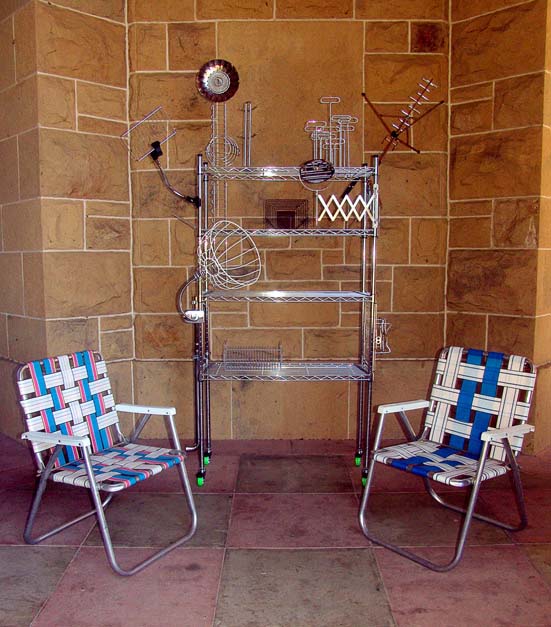
Mobile recharge station, communication tower, and transformer by Kristin Lucas.
"Algebra 2 Trig" [mp3 removed]
a cappela Sidstation with midi echoes and regular echoes. original composition
